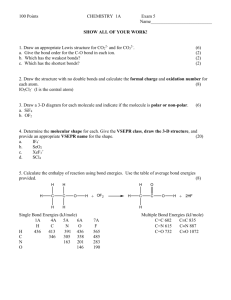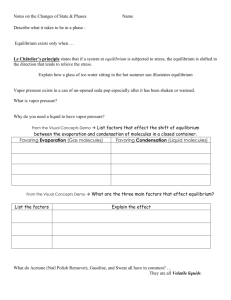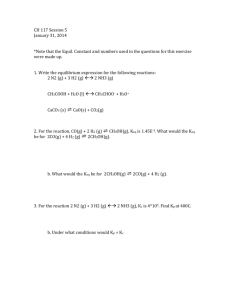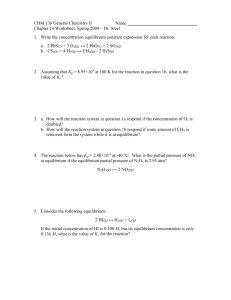Practice test for Chapter 17
advertisement
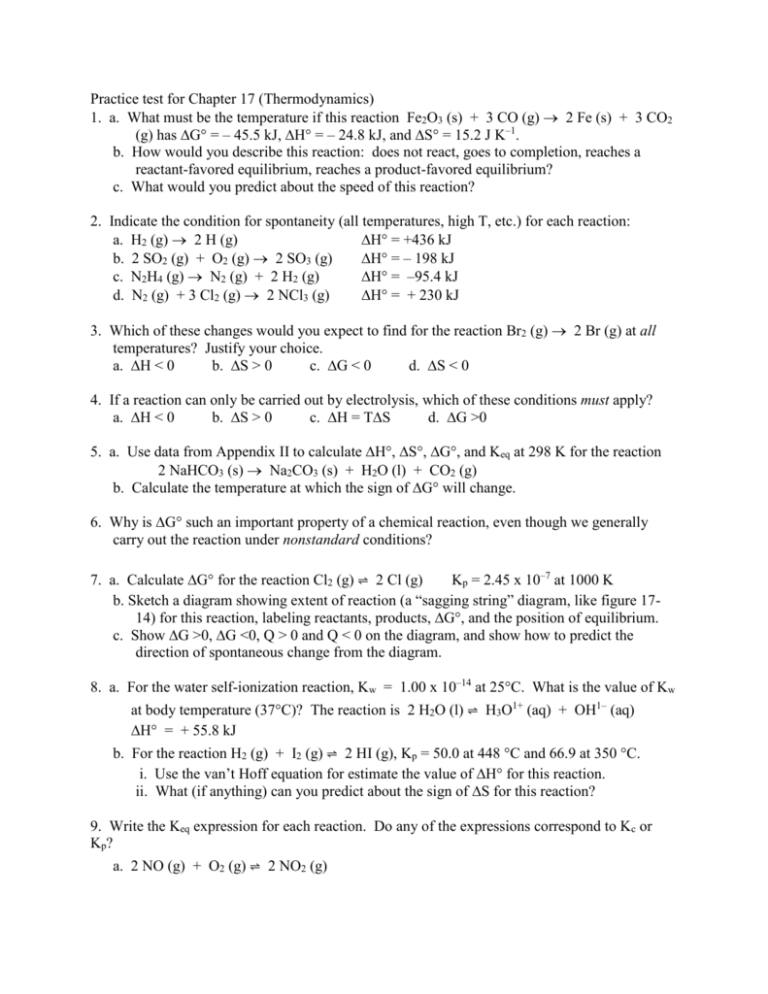
Practice test for Chapter 17 (Thermodynamics) 1. a. What must be the temperature if this reaction Fe2O3 (s) + 3 CO (g) 2 Fe (s) + 3 CO2 (g) has ∆G° = – 45.5 kJ, ∆H° = – 24.8 kJ, and ∆S° = 15.2 J K–1. b. How would you describe this reaction: does not react, goes to completion, reaches a reactant-favored equilibrium, reaches a product-favored equilibrium? c. What would you predict about the speed of this reaction? 2. Indicate the condition for spontaneity (all temperatures, high T, etc.) for each reaction: a. H2 (g) 2 H (g) ∆H° = +436 kJ b. 2 SO2 (g) + O2 (g) 2 SO3 (g) ∆H° = – 198 kJ c. N2H4 (g) N2 (g) + 2 H2 (g) ∆H° = –95.4 kJ d. N2 (g) + 3 Cl2 (g) 2 NCl3 (g) ∆H° = + 230 kJ 3. Which of these changes would you expect to find for the reaction Br2 (g) 2 Br (g) at all temperatures? Justify your choice. a. ∆H < 0 b. ∆S > 0 c. ∆G < 0 d. ∆S < 0 4. If a reaction can only be carried out by electrolysis, which of these conditions must apply? a. ∆H < 0 b. ∆S > 0 c. ∆H = T∆S d. ∆G >0 5. a. Use data from Appendix II to calculate ∆H°, ∆S°, ∆G°, and Keq at 298 K for the reaction 2 NaHCO3 (s) Na2CO3 (s) + H2O (l) + CO2 (g) b. Calculate the temperature at which the sign of ∆G° will change. 6. Why is ∆G° such an important property of a chemical reaction, even though we generally carry out the reaction under nonstandard conditions? 7. a. Calculate ∆G° for the reaction Cl2 (g) ⇌ 2 Cl (g) Kp = 2.45 x 10–7 at 1000 K b. Sketch a diagram showing extent of reaction (a “sagging string” diagram, like figure 1714) for this reaction, labeling reactants, products, ∆G°, and the position of equilibrium. c. Show ∆G >0, ∆G <0, Q > 0 and Q < 0 on the diagram, and show how to predict the direction of spontaneous change from the diagram. 8. a. For the water self-ionization reaction, Kw = 1.00 x 10–14 at 25°C. What is the value of Kw at body temperature (37°C)? The reaction is 2 H2O (l) ⇌ H3O1+ (aq) + OH1– (aq) ∆H° = + 55.8 kJ b. For the reaction H2 (g) + I2 (g) ⇌ 2 HI (g), Kp = 50.0 at 448 °C and 66.9 at 350 °C. i. Use the van’t Hoff equation for estimate the value of ∆H° for this reaction. ii. What (if anything) can you predict about the sign of ∆S for this reaction? 9. Write the Keq expression for each reaction. Do any of the expressions correspond to Kc or Kp? a. 2 NO (g) + O2 (g) ⇌ 2 NO2 (g) b. MgSO3 (s) ⇌ MgO (s) + SO2 (g) c. HC2H3O2 (aq) + H2O (l) ⇌ H3O1+ (aq) + C2H3O21– (aq) d. 2 NaHCO3 (s) ⇌ Na2CO3 (s) + H2O (g) + CO2 (g) e. MnO2 (s) + 4 H1+ (aq) + 2 Cl1– (aq) ⇌ Mn2+ (aq) + 2 H2O (l) + Cl2 (g) ANSWERS to Practice test for Chapter 17 1. a. 1360 K b. product-favored equilibrium c. Thermodynamics offers no information about speed; reaction rate is kinetics, which depends on activation energy and mechanism. It is entirely possible for a productfavored reaction to proceed slowly, and a reactant-favored reaction to reach equilibrium quickly. 2. a. spontaneous at high T, non-spontaneous at low T b. spontaneous at low T, non-spontaneous at high T c. spontaneous at all T d. non-spontaneous at all T 3. Only (b) is true at all temperatures 4. Only (d) is true. 5. ∆H° = +91 kJ, ∆S° = 215.1 J/K, ∆G° = 27 kJ, Keq = 1.8 x 10–5 ; ∆G° will change sign at 423 K 6. The sign and value of ∆G° determines the string attachment points and thus the position of equilibrium for that reaction, which is why ∆G° is important even if you’re not doing the reaction under standard conditions. 7. ∆G° = 126.6 kJ/mol. The diagram shows the free energy of the reactants on the left axis and the products on the right axis. In this case ∆G° of the reaction is >0 and the string attachment point is higher on the right than on the left. The string sags down to an equilibrium low point closer to the reactants than to the products. From any point on the string (Q) you can predict the sign of ∆G (slope of the line) and whether proceeding right or left moves you toward or away from equilibrium. At the low point, Q = Keq and ∆G = 0. 8. Use the van’t Hoff equation. (a) Kw at 37 °C is 2.39 x 10–14 (b) ∆H° = –11 kJ/mol; there is no change in the number of moles of gas, so the sign of ∆S is not obvious, but if Keq is becoming more favorable at lower temperature, then ∆G° is becoming more negative as T decreases. We know that ∆H° is negative, so this is a reaction that is more spontaneous at low T than at high T, suggesting ∆S is negative. 2 PNO 9. a. K eq 2 2 same as Kp PNO PO2 b. K eq PSO2 same as Kp H 3O1 C2 H 3O21 c. K eq HC2 H 3O2 same as Kc d. K eq PH2 O PCO2 same as Kp e. K eq Mn 2 PCl2 4 2 H 1 Cl 1 does not match Kc or Kp Review 1. The structure of atoms and ions. a. Write the complete electron configuration for N. Is N paramagnetic or diamagnetic (what do those terms mean, anyway, and what would you observe in connection with each?). b. Show that F1–, Ne, and Mg2+ are isoelectronic and write the complete electron configuration for each species. i. Compare their radii and explain. ii. From which species would it be most difficult to remove an electron, and why? 2. Bonding a. Draw the Lewis dot structures for NH3 and PH3 b. Use you knowledge of atomic orbitals and hybrid orbital sets to explain why the N–H bond angle is 107° but the P–H bond angle is 93°. [This is very tricky but showed up on the AP exam last year.] 3. a. Describe the intermolecular forces between molecules of NH3 and between molecules of PH3. b. Compare the magnitudes of each of these forces for these two species. 4. a. NH4CO2NH2 (s) 2 NH3 (g) + CO2 (g) Starting with only solid, it is found that at equilibrium the total gas pressure in the flask is 0.363 atm. Calculate the partial pressure of each gas and the value of Kp. b. A sample of pure NO2 gas decomposes at 1000 K: 2 NO2 (g) 2 NO (g) + O2 (g) Kp = 158 If the partial pressure of O2 is 0.25 atm at equilibrium, what is the total pressure in the mixture? 5. N2O4 (g) 2 NO2 (g) Kp = 0.113 at 25 °C Is a mixture of 0.0205 mol NO2 and 0.750 mol N2O4 in a 5.25 L flask at 25 °C at equilibrium? If not, which way will the reaction proceed as it comes to equilibrium? ANSWERS to review 1a. 1s2 2s22p3. N is paramagnetic (has one or more unpaired electron). Paramagnetic species are attracted to a magnetic field; diamagnetic species (all electrons paired) are weakly repelled by a magnetic field. See pg 339 in text. 1b. All have 10 electrons and are 1s2 2s22p6. Mg2+ is smallest because it has the most protons, so it pulls the electrons in tighter. It would be most difficult to remove an electron from Mg2+ because it has the most protons and the electron to be removed is closer to the nucleus. 2. Both are AX3E with a trigonal pyramidal geometry. The bond angles in NH3 suggest that the valence orbitals on N form an sp3 hybrid set; the lone pair pushes the bond pairs together, making the angle slightly less than the tetrahedral angle of 109.5°. The unexpected bond angle in PH3 suggests that the bonds are formed with unhybridized 3p orbitals, still lying along the x,y,z axes at 90°. The lone pair must be in the 3s orbital on P. 3a. NH3 molecules are attracted to each other by London dispersion forces, dipole-dipole forces due to the molecular polarity, and hydrogen bonding between molecules, an extreme case of dipole forces. PH3 molecules are attracted to each other by London dispersion forces and probably by very weak dipole-dipole forces (thanks to the lone pair on P, as otherwise the bonds are nonpolar). There is no hydrogen bonding between PH3 molecules. 3b. The London dispersion forces are directly related to molar mass, so they are stronger between PH3 molecules than between NH3 molecules. The dipole-dipole forces are quite strong between NH3 molecules, thanks to N’s high electronegativity, but very weak between PH3 molecules. 4. a. Divide the total pressure according to the stoichiometry. PNH3 = 0.242 atm, PCO2 = 0.121 atm, Kp = 7.09 x 10–3 b. Ice table! Initial PNO2 is 0.52 atm, and final PNO2 is 0.02 atm. Total P is 0.02 + 0.50 + 0.25 = 0.77 atm 5. Use PV=nRT to convert the moles to pressures, and calculate Q. Qp < Kp so reaction proceeds forward (toward products)
